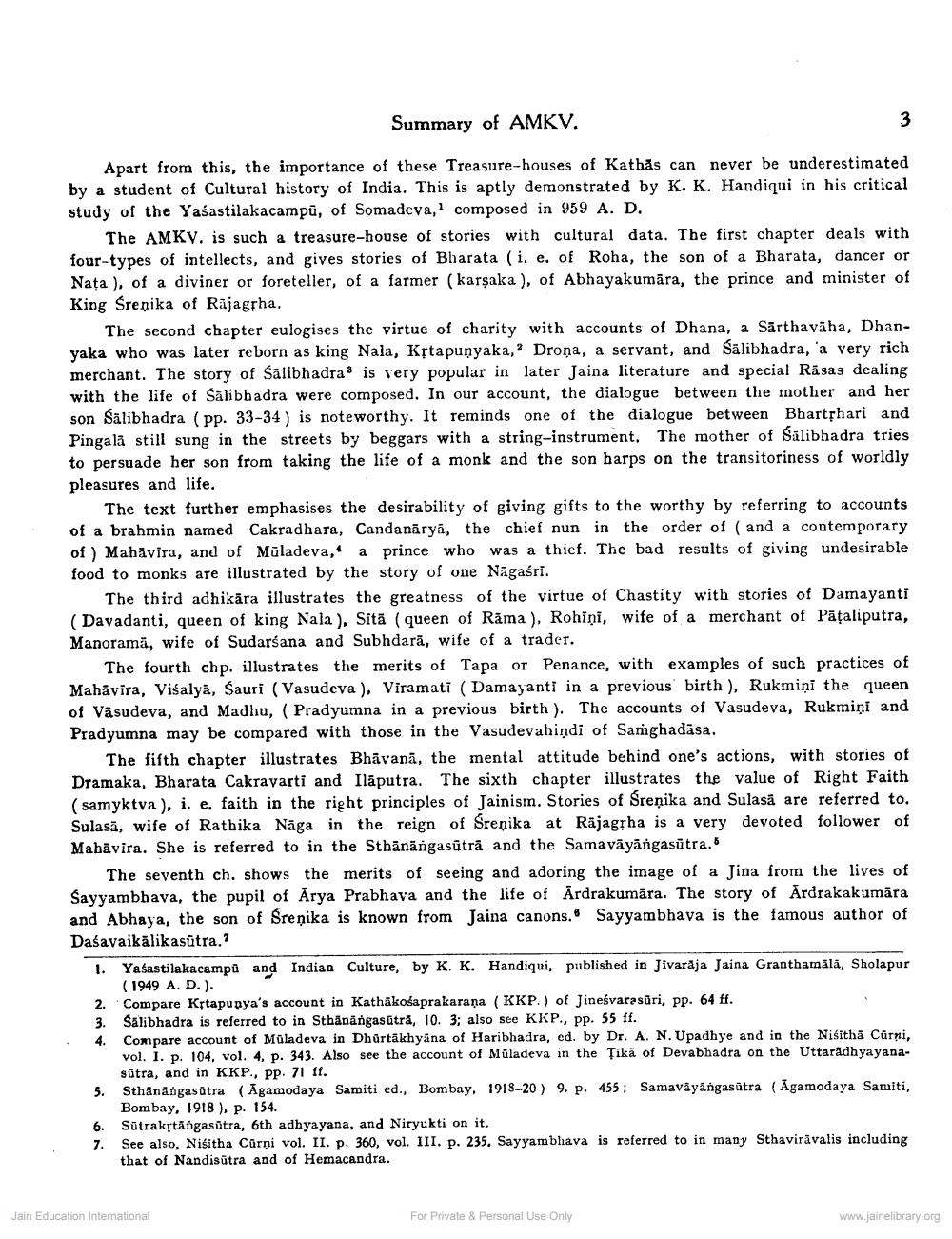________________
Summary of AMKV.
Apart from this, the importance of these Treasure-houses of Kathās can never be underestimated by a student of Cultural history of India. This is aptly demonstrated by K. K. Handiqui in his critical study of the Yaśastilakacampū, of Somadeva, composed in 959 A. D.
The AMKV. is such a treasure-house of stories with cultural data. The first chapter deals with four-types of intellects, and gives stories of Bharata (i, e, of Roha, the son of a Bharata, dancer or Nața ), of a diviner or foreteller, of a farmer (karşaka ), of Abhayakumāra, the prince and minister of King Srenika of Rajagrha,
The second chapter eulogises the virtue of charity with accounts of Dhana, a Sārthaväha, Dhanyaka who was later reborn as king Nala, Krta punyaka, Droņa, a servant, and Salibhadra, 'a very rich merchant. The story of Salibhadras is very popular in later Jaina literature and special Rāsas dealing with the life of Salibhadra were composed. In our account, the dialogue between the mother and her son Salibhadra (pp. 33-34 ) is noteworthy. It reminds one of the dialogue between Bharthari and Pingala still sung in the streets by beggars with a string-instrument. The mother of Sālibhadra tries to persuade her son from taking the life of a monk and the son harps on the transitoriness of worldly pleasures and life.
The text further emphasises the desirability of giving gifts to the worthy by referring to accounts of a brahmin named Cakradhara, Candanāryā, the chief nun in the order of (and a contemporary of) Mahāvira, and of Mūladeva, a prince who was a thief. The bad results of giving undesirable food to monks are illustrated by the story of one Nāgasri.
The third adhikāra illustrates the greatness of the virtue of Chastity with stories of Damayanti (Davadanti, queen of king Nala), Sītā (queen of Rāma ), Rohiņi, wife of a merchant of Pāšaliputra, Manorama, wife of Sudarśana and Subhdarā, wife of a trader.
The fourth chp. illustrates the merits of Tapa or Penance, with examples of such practices of Mahāyira, Višalyā, Sauri (Vasudeva ), Viramati (Damayanti in a previous birth ), Rukmini the queen of Vāsudeva, and Madhu, (Pradyumna in a previous birth). The accounts of Vasudeva, Rukmini and Pradyumna may be compared with those in the Vasudevahindi of Samghadāsa.
The fifth chapter illustrates Bhāvanā, the mental attitude behind one's actions, with stories of Dramaka, Bharata Cakravarti and Ilāputra. The sixth chapter illustrates the value of Right Faith (samyktva ), i. e. faith in the right principles of Jainism. Stories of Sreņika and Sulasă are referred to. Sulasā, wife of Ratbika Nāga in the reign of Sreņika at Rājagļha is a very devoted follower of Mabāvira. She is referred to in the Sthānāngasūtra and the Samavāyāngasūtra.
The seventh ch. shows the merits of seeing and adoring the image of a Jina from the lives of Sayyambhava, the pupil of Arya Prabhava and the life of Ardrakumāra. The story of Ardrakakumāra and Abhaya, the son of Sreņika is known from Jaina canons. Sayyambhava is the famous author of Daśavaikālikasūtra. 1. Yasastilakacampū and Indian Culture, by K. K. Handiqui, published in Jivarāja Jaina Granthamāla, Sholapur
(1949 A. D.). 2. Compare Krtapupya's account in Kathākośaprakaraņa (KKP.) of Jineśvarasüri, PP. 64 ff. 3. Salibhadra is referred to in Stbanāngasutra, 10. 3; also see KKP., pp. 55 ff. 4. Compare account of Müladeva in Dhúrtākhyāna of Haribhadra, ed. by Dr. A. N. Upadhye and in the Niśitha Cúrni,
vol. I. p. 104, vol. 4, p. 343. Also see the account of Müladeva in the Tikā of Devabhadra on the Uttaradhyayana
sutra, and in KKP., PP. 71 ff. 5. Sthânăngasūtra (Agamodaya Samiti ed., Bombay, 1918-20 ) 9. p. 455: Samavāyāngasūtra (Agamodaya Samiti,
Bombay, 1918), p. 154.
Sätrakrtāngasútra, 6th adhyayana, and Niryukti on it. 7. See also, Niśitha Cūrņi vol. II. p. 360, vol. III. p. 235. Sayyambhava is referred to in many Sthaviravalis including
that of Nandisutra and of Hemacandra.
Jain Education International
For Private & Personal Use Only
www.jainelibrary.org




